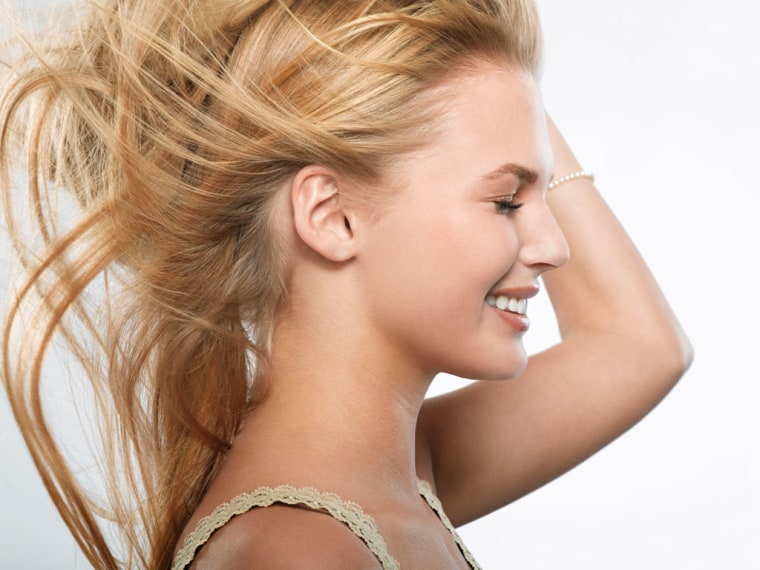First, some clarification: Fine hair is not necessarily thin hair, although the two often come together. Thin hair means simply that you don't have a lot of strands on your head—nothing you can do about it, because it's programmed at birth. Some people have thick hair that's considered fine because it's silky and smooth, without the curls or roughness that provide texture. In either case, the problem is that the hair tends to lack volume, and that's what we're looking to get.
Robert Winslow, a stylist at Laicale salon in New York City, is known for his skill working with baby-fine hair. For those women who want to achieve a fuller look without spending time or money, he recommends three simple solutions:
If you've got long hair, pull it up into a big ponytail on top of your head every night after washing it (you can also blow it dry before putting it up for even more volume). Sleep on it like that, and when you pull out the ponytail in the morning, you'll be amazed at the extra poof in your roots. The fluffy effect usually lasts all day.
- For a wavier look, tie your freshly washed hair up overnight in a big bun, or several buns on your head (again, blow it dry first if you want extra volume). You'll see undulating strands when you take it down in the morning. To go even curlier, braid your hair overnight, or tie it up in little rags like women used to do in the 17th and 18th centuries. It adds a lot of kink without the styling torture of hot irons and curlers.
- Texture can come from your own natural hair oils, although in this hygiene-happy time we usually wash our hair too frequently for secretions to build up. If you can wash your hair every other day, or even every third day, Winslow says, it will feel and act thicker. If that's a tad too bohemian for you, consider making a little saltwater solution in a spray bottle at home—several good shakes of salt in a cup of water will do—and spritzing it on your roots. The salt will cling as the water dries, giving you a fresh-from-the-beach feeling and infusing some roughness into your hair. The extra texture will lend added volume.
- Conditioning and volumizing products do a lot to add fullness and keep hair in good shape, Winslow says, but follow these tips to avoid oversaturation:
- If using a conditioner, apply it mostly on the ends of hair to avoid weighing down the roots.
- If using a volumizing mousse or gel, apply sparingly to roots.
- Blow your hair dry upside down, with your head flipped over and the heat directed at your roots. Dry the hair this way first and then turn your head up if you want to style a certain section.
- Apply hairspray to the roots of your hair, again by flipping it upside down.
- A good way to keep some of the volume that blow-drying produces is to put Velcro curlers in your hair while it cools down. Use small curlers for tight curls, medium-sized for medium curls and big rollers for loose waves.
- If you're really looking for a dramatic increase in volume, there are tricks a stylist can do that involve some chemical changes to your hair's texture and color, or adding someone else's hair to your own.
- Getting highlights is an easy way to instantly add volume. The layered colors give some visual depth to the hair, leaving an impression of volume, and the color treatments tend to roughen the hair a bit, giving you some natural texture.
- Getting a permanent wave, once seen as the most evil thing you could do to your hair, has gradually been accepted back into the fold of permissible treatments, mostly because improved technology has done away with the tightly frizzed look of the 1980s. Still, a perm uses chemicals to temporarily alter your hair's character—from straight and fine you can go to full and curly, but results vary. A good perm can be a lifesaver, but a bad one's heartbreaking—and it won't go away until new hair grows out. Talk it over with your stylist beforehand and consider every pro and con.
- Extensions and weaves have been around for a long time, but sadly for us, the girls who most need them have the hardest time living with them. That's because extensions and weaves are actually tied into existing hair right at the root and then left to grow out. The technique can cause a lot of breakage and damage—not to mention pain—during the attachment process. If your hair is in good condition and your stylist has experience with extensions, this could be a good option. But remember, regular upkeep is needed.
- Finally, if you aren't squeamish, consider having a "fusion" of human hair steamed onto your existing hair. It's usually done with hot glue and, if done right, can be less damaging and look more natural than a weave. But avoid the do-it-at-home kits and stick to a trained specialist. Aside from the hot glue gun that will be pointing at your head, you really want to make sure you are getting high-quality hair that matches your own color well. Otherwise, Winslow notes, the results are pretty tacky.
A version of this story originally appeared on iVillage.
